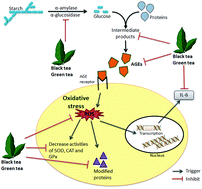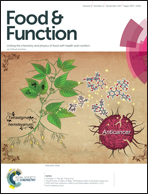Comparative suppressing effects of black and green teas on the formation of advanced glycation end products (AGEs) and AGE-induced oxidative stress
Abstract
This study aimed at investigating and comparing the anti-diabetic potential of black and green teas. Biochemical analyses indicate higher antioxidant potency, significantly correlated with the phytochemicals present, in green teas compared to black teas. Both extracts afforded a similar level of protection to erythrocytes against peroxyl radical-induced lysis. Non-cytotoxic concentration of green and black tea extracts significantly reduced the reactive oxygen species (ROS) production (P < 0.01), lowered the oxidation of proteins (P < 0.05) and decreased the IL-6 secretion (P < 0.01) induced by AGEs or H2O2 in 3T3-L1 preadipocytes. Both teas also inhibited the decline in the enzymatic activities of superoxide dismutase, catalase and glutathione peroxidase induced by the pro-oxidants. The teas further suppressed the glycation of BSA mediated by glucose, ribose and MGO by reducing fluorescent AGE, fructosamine, protein carbonyl and AOPP levels. Black and green teas also inhibited the activities of α-amylase (AA50: 589.86 ± 39.51 and 947.80 ± 18.20 μg mL−1, respectively) and α-glucosidase (AA50: 72.31 ± 4.23 and 100.23 ± 8.10 μg mL−1, respectively). The teas afforded a comparable level of protection at the cellular level and against glycation while black tea exerted the highest carbohydrate hydrolysing enzymes inhibitory activity. Our results clearly show that black and green teas represent an important source of antioxidants with anti-diabetic potential.



 Please wait while we load your content...
Please wait while we load your content...